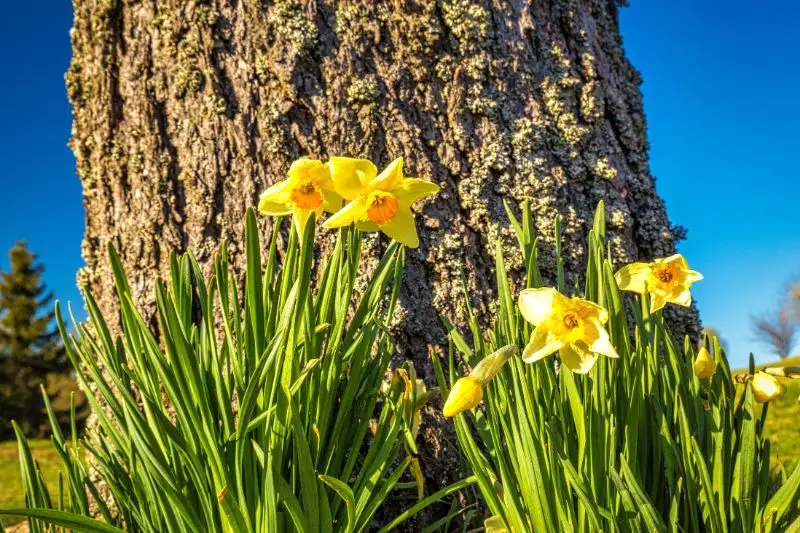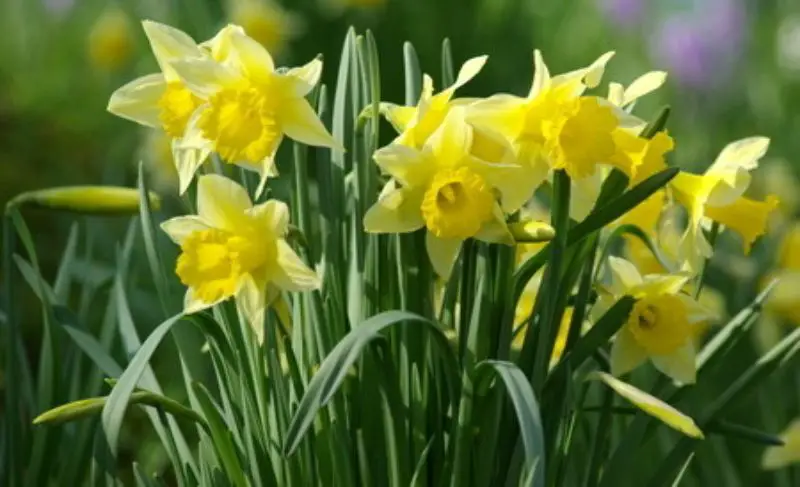Daffodils, with their bright yellow petals and trumpet-shaped centers, are a beloved symbol of spring. They are easy to grow, low maintenance, and add a cheerful touch to any garden or landscape. However, there are some important things to keep in mind when it comes to these lovely flowers. In this article, we will share seven tips that every daffodil enthusiast should know.
Firstly, it is important to always pick daffodils rather than cut them. Secondly, daffodils rarely need fertilizer to thrive. Thirdly, it is crucial to remember that every part of the daffodil plant is poisonous. Fourthly, be aware that including daffodils in a bouquet can cause cut flowers to fade faster. Fifthly, daffodils can grow in full sun or partial shade. Sixthly, they can prevent grass from growing around a fruit tree. Lastly, daffodils can even be used to prevent erosion on a hillside.
By following these tips, you can enjoy the beauty and benefits of daffodils while also avoiding any potential pitfalls. So let’s dive in and learn more about these delightful flowers.

1. Always Pick Daffodils, And Never Cut Them
When it comes to harvesting daffodils, it’s important to remember that cutting them isn’t the best method. Instead, you should always pick them by reaching down to the base of the stem and snapping it off. This is because cutting daffodils can result in a shorter, hollow stem that doesn’t draw water well, causing the flowers to wilt faster. By picking them, you get a longer stem and fresher flowers.
It’s also crucial to choose healthy and firm daffodil bulbs for planting. When picking daffodils, aim for morning time before the afternoon sun has robbed them of moisture. Daffodils prefer full sun and good drainage, so make sure to plant them in areas with these conditions. Deep planting can help prevent frost heave and accidental damage.
In addition to proper harvesting techniques and planting methods, proper care of daffodils is also essential for their long-term health. Watering regularly is crucial, especially in spring and autumn when they are actively growing or preparing for growth later on. When planting your bulbs initially, ensure they’re well-watered at planting time; keeping soil moist throughout flowering season helps guarantee strong blooms as well as good health overall. Mulching newly planted beds can aid in weed suppression while also ensuring consistent moisture retention at all times – which benefits not just foliage but root development too.

2. Daffodils Rarely Need Fertilizer
Daffodils are low-maintenance flowers that do not require a lot of attention, including fertilizer. In fact, these plants can typically thrive without any added nutrients. If you find that your soil is poor or your daffodils aren’t flowering properly, you may want to consider top dressing with bulb food when the leaves emerge. However, it’s important to use high-nitrogen fertilizer sparingly or avoid it altogether, as over-supplying your daffodils with nitrogen can actually prevent them from flowering.
When watering your daffodils, make sure to do so regularly – especially during growth and blooming periods – but be cautious not to overwater them during summer months. Though mature daffodils will respond well to early spring fertilizers such as liquid fish emulsion mixed with water, they typically don’t need additional feeding.
If you decide to use fertilizer on your daffodil bulbs before planting for added nutritional value – which is not necessary but can be helpful in poor soils – consider using granular bulb-specific products instead of general fertilizers. Work the granules into the soil before planting rather than digging them directly into the hole where the bulb will go. Daffodils also only require division infrequently and naturally store their own reserves of nutrients within their bulbs.
In summary, while it’s always good practice to take care of your garden plants by providing proper nutrition and watering needs, sometimes less intervention is more beneficial. Keep these tips in mind when caring for your beloved daffodil plants so that they continue bring sunshine to your outdoor space year after year without unnecessary fussing.

3. Every Part Of The Daffodil Plant Is Poisonous
Daffodils are a beautiful and popular addition to gardens around the world. However, it’s important to remember that every part of the daffodil plant is toxic. Ingestion of any part of the plant can lead to unpleasant symptoms such as nausea, vomiting, diarrhea, and abdominal pain.
Pets such as cats, dogs, and horses are particularly vulnerable to daffodil poisoning. Common signs include vomiting, excess saliva, diarrhea, and instability or dizziness. The toxins in daffodils can cause convulsions, seizures or heart problems in pets which could even lead to their death.
The bulbs are the most poisonous part of the plant and should be avoided at all costs. If ingested by pets or humans it causes severe mouth irritation and stomach upset. It is important that bulbs be kept away from animals especially during spring when they may mistake them for food.
Lycorine found in daffodils is harmful too causing nausea, vomiting and diarrhea while alkaloids found in them known as haemanthamine can pose serious health risks when ingested even causing paralysis if taken in large amounts. Lastly, it’s good practice not handle cut flowers or plants with bare hands as sap contains dangerous skin irritants including crystals oxalic acid which could make a simple sensitize condition worse.
In conclusion – while these flowers look lovely it’s important to keep children small animals well away from them- NEVER bring cut flowers where there may be pets present because ingestion can occur within an unsupervised second.

4. Daffodils In A Bouquet Cause Cut Flowers To Fade Faster
One important tip to keep in mind when arranging a bouquet with daffodils is to separate them from other flowers for at least 24 hours. Daffodil stems release a latex when cut that can cause other flowers to fade faster. To prevent this, store the daffodils in a separate vase before adding them to the mixed arrangement.
When cutting daffodils, it’s best to pick them when the flower bud is just starting to show color and cut at a 90-degree angle. This ensures that they will last longer once added into the bouquet. To prolong their life even further, recut the stems and replace the water and preservative every two days. It’s also important to change the water every couple of days since daffodils thrive in shallow water.
After blooming, it’s recommended to leave the foliage of daffodils in place since it helps build up their bulb for next season. By following these tips, you can ensure that your mixed bouquet looks beautiful for longer without sacrificing any blooms due to the presence of daffodils.

5. Daffodils Can Grow In Full Sun Or Partial Shade
Daffodils are beautiful flowers that can thrive in various lighting conditions. They prefer full sun, but they can also grow in partial shade. In fact, planting daffodils under deciduous trees is an excellent strategy as they will receive plenty of light before the trees fill out in the spring.
Having well-draining soil is essential for growing daffodils. They don’t like soggy soil, so make sure water doesn’t pool around their roots, which would cause bulb rot. One exciting aspect of daffodils is that people can plant them almost anywhere: pots, containers, borders or even naturalized in lawns.
Ensure daffodils get at least four hours of sunlight daily to ensure success and help them last longer throughout the season. These flowers are winter-hardy and perfect for Zones 3-8 within North America when starting from scratch.
Over time, Daffodil bulbs may need division if producing fewer blooms compared to previous years or if you want to redistribute them throughout your garden or home. To do this delicately lift and separate bulbs at regular intervals after each blooming cycle; However,- avoid chopping up larger clumps into smaller pieces as it could lead to a lack of true colors underneath your soil’s surface.
In conclusion ensure if planting Daffodil into your gardens or even homes new pots be sure always opt for good drainage material known best to women homemakers since ages is placing stones on the bottom layer to promote better water flow which increases their lifespan and discourages bulb rot –enjoy some gorgeous blossoms with either white rims yellow centers that can flourish fully under trees and occasionally on direct sunlight.

6. Daffodils Can Prevent Grass Around A Fruit Tree
If you have a fruit or nut tree in your yard, you may want to consider planting daffodils around the drip line. The bulbs can prevent grass from growing and competing for water and nutrients with your tree. Planting daffodils in a circle at the drip line of your fruit or nut tree can keep grass from encroaching and sapping valuable resources from your trees.
Daffodils are also useful for repelling deer and other animals who might graze on or near your fruit trees. By keeping these animals away, you protect both the trees and any potential harvest that they may provide. In addition to their pest-repellent properties, daffodils are also helpful as part of a fruit tree guild. They attract pollinators that can help with fertilization while providing beauty to your garden.
When planting daffodils around a fruit or nut tree, it’s important to choose an appropriate location at the drip line where the bulbs won’t be disturbed by competition roots from other plants. This is typically located about 2-3 feet away from trunk of the tree for every inch of trunk diameter. Daffodils require well-draining soil but will not grow well in waterlogged soil since it can cause bulb rot.
Overall, planting daffodils around a fruit or nut tree is an easy way to maintain its health and beauty without suppressing growth or causing harm to surrounding vegetation. By doing so, you’ll show how much effort you put into making sure everything around is thriving naturally while reaping an awesome crop.

7. You Can Use Daffodils To Prevent Erosion On A Hillside
When it comes to controlling erosion on a sloped area, daffodils can be an effective option. These bright yellow flowers not only add beauty to your yard or wooded area, but they also repel diggers like gophers and moles. To ensure that they thrive in these conditions, it’s important to plant them twice as deep as the bulb is tall. This helps prevent frost heave and accidental damage.
Daffodils prefer neutral to slightly acidic soil with excellent drainage and regular watering in spring and fall. However, they should not be planted in areas where small children or pets may come into contact with them since their toxic sap can cause wilting. Additionally, when placing daffodils in a vase of water for floral arrangements, make sure there are no other flower types present as their toxic sap can affect other flowers.
Aside from their usefulness for erosion control, daffodils have several benefits that make them a great addition to any garden or landscape. For instance, they bloom early in the season and can provide cheerful color after long winters before many other plants have started blooming yet. Plus, once established, these flowers require very little maintenance making them a low-maintenance landscaping option. With proper care and planting techniques, you can enjoy using daffodils as an effective solution for preventing soil erosion on your hillside while also enjoying their beauty throughout the year.
